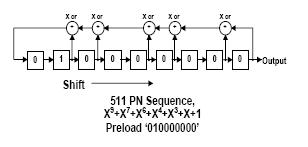raka200
Member level 2

Hi everybody !!!!
Does anyboy could explain me how to go from a PN sequence expression to the block diagram ???
For example, in ATSC, there is a PN511 sequence used for the sync field segment.
The expression for this sequence is X9+X7+X6+X4+X3+X+1
I thought we have to build a 9 taps shift register, and xor the taps 9,7,6,4,6,3,1 with '1', then barrel shift left (9 tap is oldest).
But the hardware implementation seems (to me ;-)) very different to the expression....

Could someone tell me how to get from the sequence expression to the block diagram ????
Thank !
Does anyboy could explain me how to go from a PN sequence expression to the block diagram ???
For example, in ATSC, there is a PN511 sequence used for the sync field segment.
The expression for this sequence is X9+X7+X6+X4+X3+X+1
I thought we have to build a 9 taps shift register, and xor the taps 9,7,6,4,6,3,1 with '1', then barrel shift left (9 tap is oldest).
But the hardware implementation seems (to me ;-)) very different to the expression....

Could someone tell me how to get from the sequence expression to the block diagram ????
Thank !

